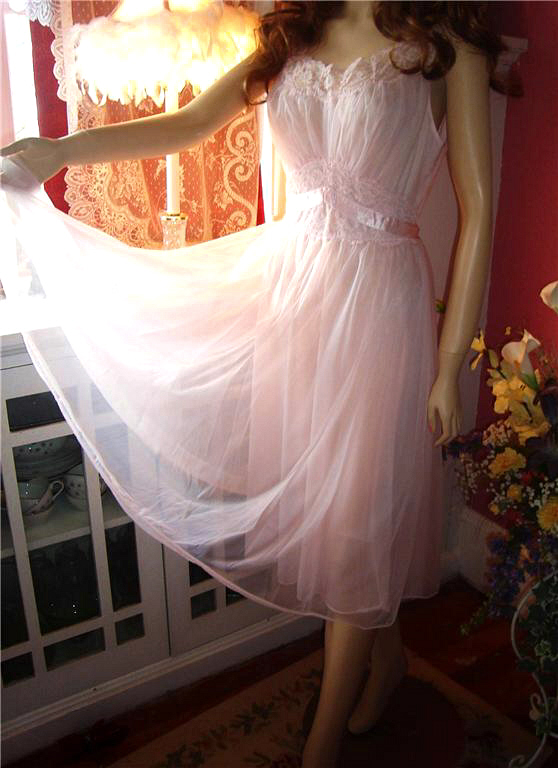Déshabillé on:
[Wikipedia]
[Google]
[Amazon]
 The negligee or ''négligée'' (french: négligé ; ), also known in French as déshabillé (), is a form of see-through clothing for women consisting of a sheer, usually long, dressing gown. It is a form of
The negligee or ''négligée'' (french: négligé ; ), also known in French as déshabillé (), is a form of see-through clothing for women consisting of a sheer, usually long, dressing gown. It is a form of
 The negligee or ''négligée'' (french: négligé ; ), also known in French as déshabillé (), is a form of see-through clothing for women consisting of a sheer, usually long, dressing gown. It is a form of
The negligee or ''négligée'' (french: négligé ; ), also known in French as déshabillé (), is a form of see-through clothing for women consisting of a sheer, usually long, dressing gown. It is a form of nightgown
A nightgown, nightie or nightdress is a loosely hanging item of nightwear, and is commonly worn by women and girls. A nightgown is made from cotton, silk, satin, or nylon and may be decorated with lace appliqués or embroidery at the bust and hem ...
intended for wear at night and in the bedroom. It was introduced in France in the 18th century, where it mimicked the heavy head-to-toe style of women's day dresses of the time.
By the 1920s, the negligee began to mimic women's satin single-layer evening dress
Evening dress, evening attire, or evening wear may refer to:
* Evening gown or evening dress
* Full evening dress or white tie, a formal Western dress code
* Black tie, a semi-formal Western dress code for evening events
* Evening Attire (horse), a ...
of the period. The term "negligee" was used on a Royal Doulton run of ceramic figurines in 1927, showing women wearing what appears to be a one-piece knee-length silk or rayon
Rayon is a semi-synthetic fiber, made from natural sources of regenerated cellulose, such as wood and related agricultural products. It has the same molecular structure as cellulose. It is also called viscose. Many types and grades of viscose f ...
slip, trimmed with lace. Although the evening-dresses style of nightwear made moves towards the modern negligee style—translucent bodices, lace trimming, bows, exemplified in 1941 by a photo of Rita Hayworth in ''Life''—it was only after World War II that nightwear changed from being primarily utilitarian to being primarily sensual or even erotic
Eroticism () is a quality that causes sexual feelings, as well as a philosophical contemplation concerning the aesthetics of sexual desire, sensuality, and romantic love. That quality may be found in any form of artwork, including painting, scul ...
; the negligee emerged strongly as a form of lingerie.
Modern negligees are often much looser and made of sheer and diaphanous fabrics and trimmed with lace or other fine material and bows. Multiple layers of fabric are often used. The modern negligee thus perhaps owes more to women's fine bedjackets or bed-capes, and up-market slips than to the nightgown
A nightgown, nightie or nightdress is a loosely hanging item of nightwear, and is commonly worn by women and girls. A nightgown is made from cotton, silk, satin, or nylon and may be decorated with lace appliqués or embroidery at the bust and hem ...
. It spread to a mass market, benefiting from the introduction of cheap synthetic Synthetic things are composed of multiple parts, often with the implication that they are artificial. In particular, 'synthetic' may refer to:
Science
* Synthetic chemical or compound, produced by the process of chemical synthesis
* Synthetic o ...
fabrics such as nylon and its finer successors. From the 1940s to the 1970s, the trend was for negligees to become shorter in length (e.g. the babydoll
A babydoll is a short, sleeveless, loose-fitting nightgown
A nightgown, nightie or nightdress is a loosely hanging item of nightwear, and is commonly worn by women and girls. A nightgown is made from cotton, silk, satin, or nylon and may be ...
of the 1970s). Negligees made from the 1940s to the 1970s are now collectible vintage items.
In the UK in 2004, negligees accounted for only four percent of women's nightwear sales, women's pyjamas having dominated since the mid-1980s. However, UK negligee sales are said to have been the fastest increasing sector of the market since 1998.
References
External links
{{DEFAULTSORT:Negligee Nightwear Gowns Lingerie Women's clothing